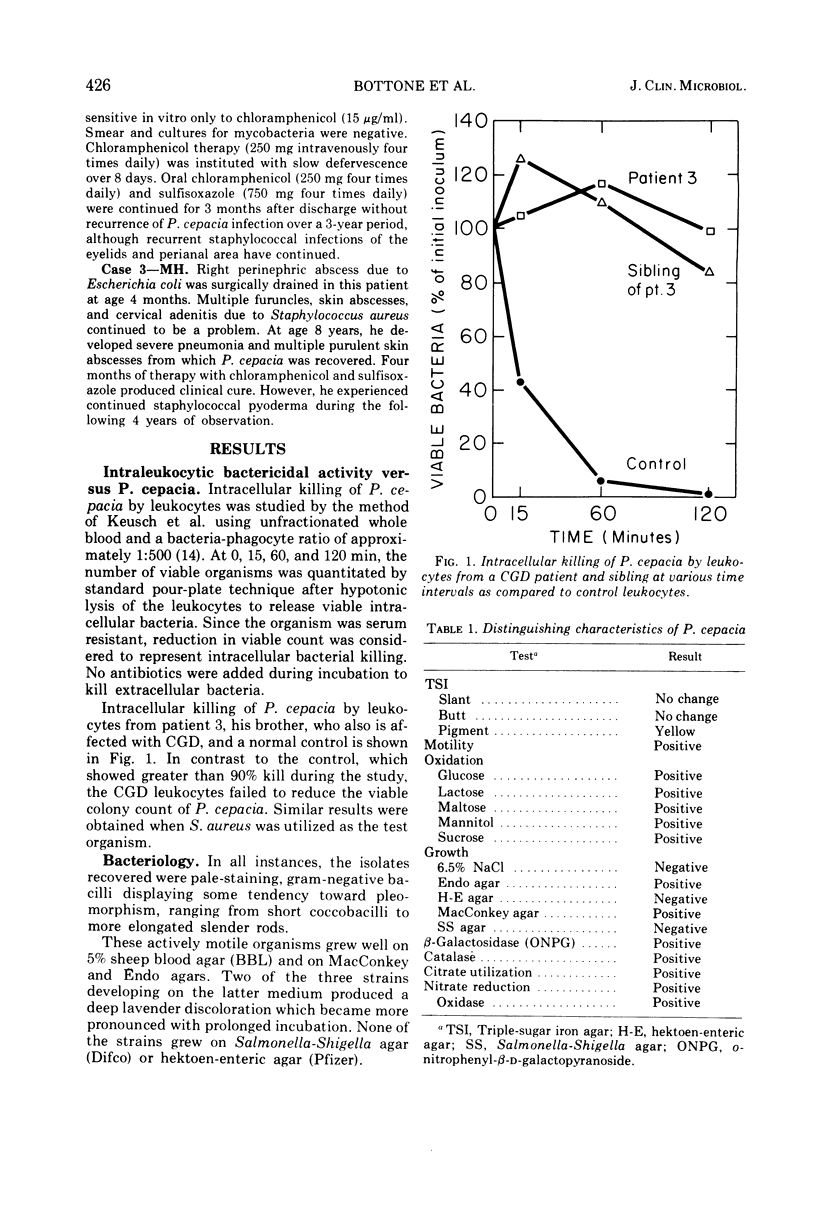Abstract
Pseudomonas cepacia was recovered from a number of infected sites in three patients with chronic granulomatous disease of childhood. The organisms were identified on the basis of their oxidative utilization of a variety of carbohydrates and their positive beta-galactosidase and oxidase activities. They were resistant to most antimicrobial agents and moderately susceptible to chloramphenicol. Peripheral blood leukocytes isolated from two siblings with chronic granulomatous disease, including one of the patients in this series, failed to kill P. cepacia in vitro. Prolonged prophylactic and antimicrobial therapy may well have played a significant role in the colonization and infection of these patients with P. cepacia.
Full text
PDF



Selected References
These references are in PubMed. This may not be the complete list of references from this article.
- Bassett D. C., Stokes K. J., Thomas W. R. Wound infection with Pseudomonas multivorans. A water-borne contaminant of disinfectant solutions. Lancet. 1970 Jun 6;1(7658):1188–1191. doi: 10.1016/s0140-6736(70)91783-6. [DOI] [PubMed] [Google Scholar]
- Burdon D. W., Whitby J. L. Contamination of hospital disinfectants with Pseudomonas species. Br Med J. 1967 Apr 15;2(5545):153–155. doi: 10.1136/bmj.2.5545.153. [DOI] [PMC free article] [PubMed] [Google Scholar]
- Dailey R. H., Benner E. J. Necrotizing pneumonicitis due to the pseudomonad "eugonic oxidizer--group I". N Engl J Med. 1968 Aug 15;279(7):361–362. doi: 10.1056/NEJM196808152790706. [DOI] [PubMed] [Google Scholar]
- Davis W. C., Douglas S. D., Fudenberg H. H. A selective neutrophil dysfunction syndrome: impaired killing of staphylococci. Ann Intern Med. 1968 Dec;69(6):1237–1243. doi: 10.7326/0003-4819-69-6-1237. [DOI] [PubMed] [Google Scholar]
- Ederer G. M., Matsen J. M. Colonization and infection with Pseudomonas cepacia. J Infect Dis. 1972 Jun;125(6):613–618. doi: 10.1093/infdis/125.6.613. [DOI] [PubMed] [Google Scholar]
- Gilardi G. L. Characterization of EO-1 strains (Pseudomonas kingii) isolated from clinical specimens and the hospital environment. Appl Microbiol. 1970 Sep;20(3):521–522. doi: 10.1128/am.20.3.521-522.1970. [DOI] [PMC free article] [PubMed] [Google Scholar]
- Gilardi G. L. Infrequently encountered Pseudomonas species causing infection in humans. Ann Intern Med. 1972 Aug;77(2):211–215. doi: 10.7326/0003-4819-77-2-211. [DOI] [PubMed] [Google Scholar]
- Gold R. H., Douglas S. D., Preger L., Steinbach H. L., Fudenberg H. H. Roentgenographic features of the neutrophil dysfunction syndromes. Radiology. 1969 Apr;92(5):1045–1054. doi: 10.1148/92.5.1045. [DOI] [PubMed] [Google Scholar]
- HUGH R., LEIFSON E. The taxonomic significance of fermentative versus oxidative metabolism of carbohydrates by various gram negative bacteria. J Bacteriol. 1953 Jul;66(1):24–26. doi: 10.1128/jb.66.1.24-26.1953. [DOI] [PMC free article] [PubMed] [Google Scholar]
- Hamilton J., Burch W., Grimmett G., Orme K., Brewer D., Frost R., Fulkerson C. Successful treatment of Pseudomonas cepacia endocarditis with trimethoprim-sulfamethoxazole. Antimicrob Agents Chemother. 1973 Nov;4(5):551–554. doi: 10.1128/aac.4.5.551. [DOI] [PMC free article] [PubMed] [Google Scholar]
- Hardy P. C., Ederer G. M., Matsen J. M. Contamination of commercially packaged urinary catheter kits with the pseudomonad EO-1. N Engl J Med. 1970 Jan 1;282(1):33–35. doi: 10.1056/NEJM197001012820108. [DOI] [PubMed] [Google Scholar]
- Johnston R. B., Jr, Baehner R. L. Chronic granulomatous disease: correlation between pathogenesis and clinical findings. Pediatrics. 1971 Nov;48(5):730–739. [PubMed] [Google Scholar]
- Mitchell R. G., Hayward A. C. Postoperative urinary-tract infections caused by contaminated irrigating fluid. Lancet. 1966 Apr 9;1(7441):793–795. doi: 10.1016/s0140-6736(66)91866-6. [DOI] [PubMed] [Google Scholar]
- Moody M. R., Young V. M., Kenton D. M. In vitro antibiotic susceptibility of pseudomonads other than Pseudomonas aeruginosa recovered from cancer patients. Antimicrob Agents Chemother. 1972 Nov;2(5):344–349. doi: 10.1128/aac.2.5.344. [DOI] [PMC free article] [PubMed] [Google Scholar]
- Phillips I., Eykyn S., Curtis M. A., Snell J. J. Pseudomonas cepacia (multivorans) septicaemia in an intensive-care unit. Lancet. 1971 Feb 20;1(7695):375–377. doi: 10.1016/s0140-6736(71)92212-4. [DOI] [PubMed] [Google Scholar]
- Riley P. S., Tatum H. W., Weaver R. E. Pseudomonas putrefaciens isolates from clinical specimens. Appl Microbiol. 1972 Nov;24(5):798–800. doi: 10.1128/am.24.5.798-800.1972. [DOI] [PMC free article] [PubMed] [Google Scholar]
- SCHIFF J., SUTER L. S., GOURLEY R. D., SUTLIFF W. D. Flavobacterium infection as a cause of bacterial endocarditis. Report of a case, bacteriologic studies, and review of the literature. Ann Intern Med. 1961 Sep;55:499–506. doi: 10.7326/0003-4819-55-3-499. [DOI] [PubMed] [Google Scholar]
- SCHNEIERSON S. S., AMSTERDAM D. A simplified tube procedure for the routine determination of bacterial sensitivity to antibiotics. Am J Clin Pathol. 1959 Jan;31(1):81–86. doi: 10.1093/ajcp/31.1_ts.81. [DOI] [PubMed] [Google Scholar]
- SORRELL W. B., WHITE L. V. Acute bacterial endocarditis caused by a variant of the genus Herrellea. Am J Clin Pathol. 1952 Feb;23(2):134–138. doi: 10.1093/ajcp/23.2.134. [DOI] [PubMed] [Google Scholar]
- Speller D. C., Stephens M. E., Viant A. C. Hospital infection by Pseudomonas cepacia. Lancet. 1971 Apr 17;1(7703):798–799. doi: 10.1016/s0140-6736(71)91236-0. [DOI] [PubMed] [Google Scholar]
- Subramaniam S., Tuman D., Rausen A. R., Douglas S. D. "Ascites" and inguinal hernias: unusual presentation for chronic granulomatous disease of childhood. Mt Sinai J Med. 1974 Jul-Aug;41(4):566–569. [PubMed] [Google Scholar]
- Weinstein A. J., Moellering R. C., Jr, Hopkins C. C., Goldblatt A. Pseudomonas cepacia pneumonia. Am J Med Sci. 1973 Jun;265(6):491–494. doi: 10.1097/00000441-197306000-00008. [DOI] [PubMed] [Google Scholar]
- von Graevenitz A., Simon G. Potentially pathogenic, nonfermentative, H2S-producing gram-negative rod (1 b). Appl Microbiol. 1970 Jan;19(1):176–176. doi: 10.1128/am.19.1.176-176.1970. [DOI] [PMC free article] [PubMed] [Google Scholar]


